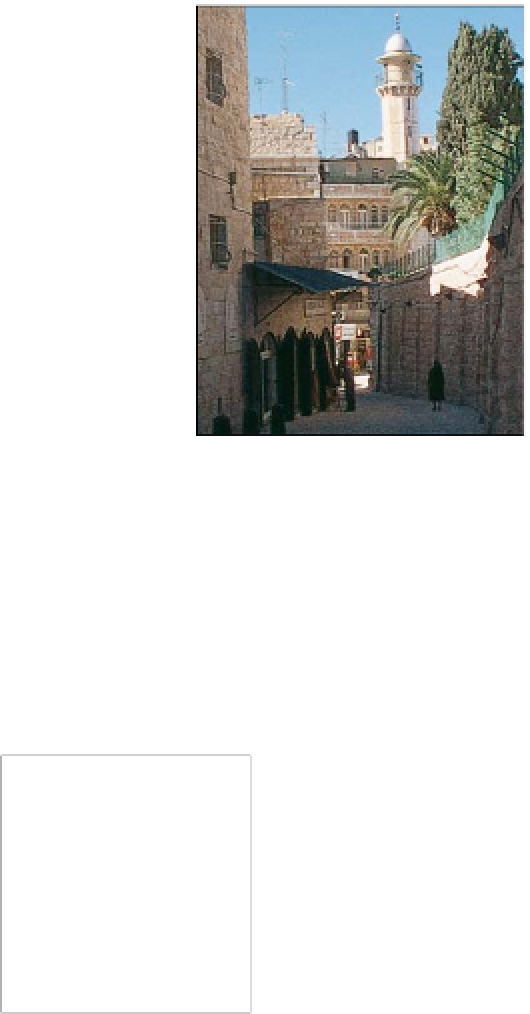Travel Reference
In-Depth Information
inside buildings. The
last five Stations are
all within the Holy
Sepulchre church
(see pp92-5)
.
Friday is the main
day for pilgrims,
when, at 3pm, the
Franciscans lead a
procession along
the route.
In fact, the more
likely route for the
original Via Dolorosa
begins at what is
now the Citadel
(see
pp102-103)
but was
at the time the royal
palace. This is where
Pontius Pilate resided
when in Jerusalem,
making it a more
likely location for the
trial of Christ. From here, the
condemned would probably
have been led down what is
now David Street, through the
present-day Central Souk
(see
p66)
, out of the then city gate
and to the hill of Golgotha,
the presumed site of which is
now occupied by the Holy
Sepulchre church.
of the façades are composed
of bands of different hues of
stone, a strikingly beautiful
Mameluke decorative tech-
nique known as
ablaq
.
Cotton Merchants'
Market
5
Off El-Wad Rd
.
Map
4 D3.
Known in Arabic as the
Souk el-Qattanin, this is a
covered market with next to
no natural light but lots of
small softly-lit shops. It is
possibly the most atmospheric
street in all the Old City. Its
construction was begun by
the Crusaders. They intended
the market as a free-standing
structure but later, in the first
half of the 14th century, the
Mamelukes connected it to
the Haram esh-Sharif
(see
An unusually quiet Via Dolorosa, leading down
from Ecce Homo Arch to El-Wad Road
prevents you from standing
back and appreciating the
building as a whole, but you
can admire the three great
doorways with their beautiful
inlaid-marble decoration. The
upper portion of a window
recess also displays some fine
carved-stone, stalactite-like
decoration, a form known as
muqarnas
. The former palace
now serves as an orphanage
and is not open to the public.
When Lady Tunshuq died,
she was buried in a small
tomb across from the palace.
The fine decoration on the
tomb includes panels of
different coloured marble,
intricately shaped and slotted
together like a jigsaw - a
typical Mameluke feature
known as “joggling”.
If you head east and across
El-Wad Road, you will enter a
narrow alley called Ala ed-
Din, which contains more fine
Mameluke architecture. Most
f
pp68-73)
via a splendidly
ornate gate facing the Dome
of the Rock. (But note, non-
Muslims are not allowed to
enter the Haram esh-Sharif by
this gate, although you can
depart this way.)
As well as some 50 shop
units, the market also has two
bathhouses, the Hammam el-
Ain and the Hammam el-Shifa.
One of these has been under-
going restoration with a view
to its being eventually opened
to the public. Between the
two bathhouses is a former
merchants' hostel called Khan
Tankiz, also being restored.
Less than 50 m (160 ft)
south of the Cotton Merchants'
Market on El-Wad Road is a
small public drinking fountain,
or
sabil
, one of several such
erected during the reign of
Suleyman the Magnificent.
Stalactite stone carvings above a
window on Lady Tunshuq's Palace
Lady Tunshuq's
Palace
4
El-Takiya St.
Map
4 D3.
¢
to public.
Lady Tunshuq, of Mongolian
or Turkish origin, was the
wife, or mistress, of a Kurdish
nobleman. She arrived in
Jerusalem some time in the
14th century and had this
edifice built for herself. It is
one of the loveliest examples
of Mameluke architecture in
Jerusalem. Unfortunately the
narrowness of the street
The tunnel-like interior of the Cotton Merchants' Market













